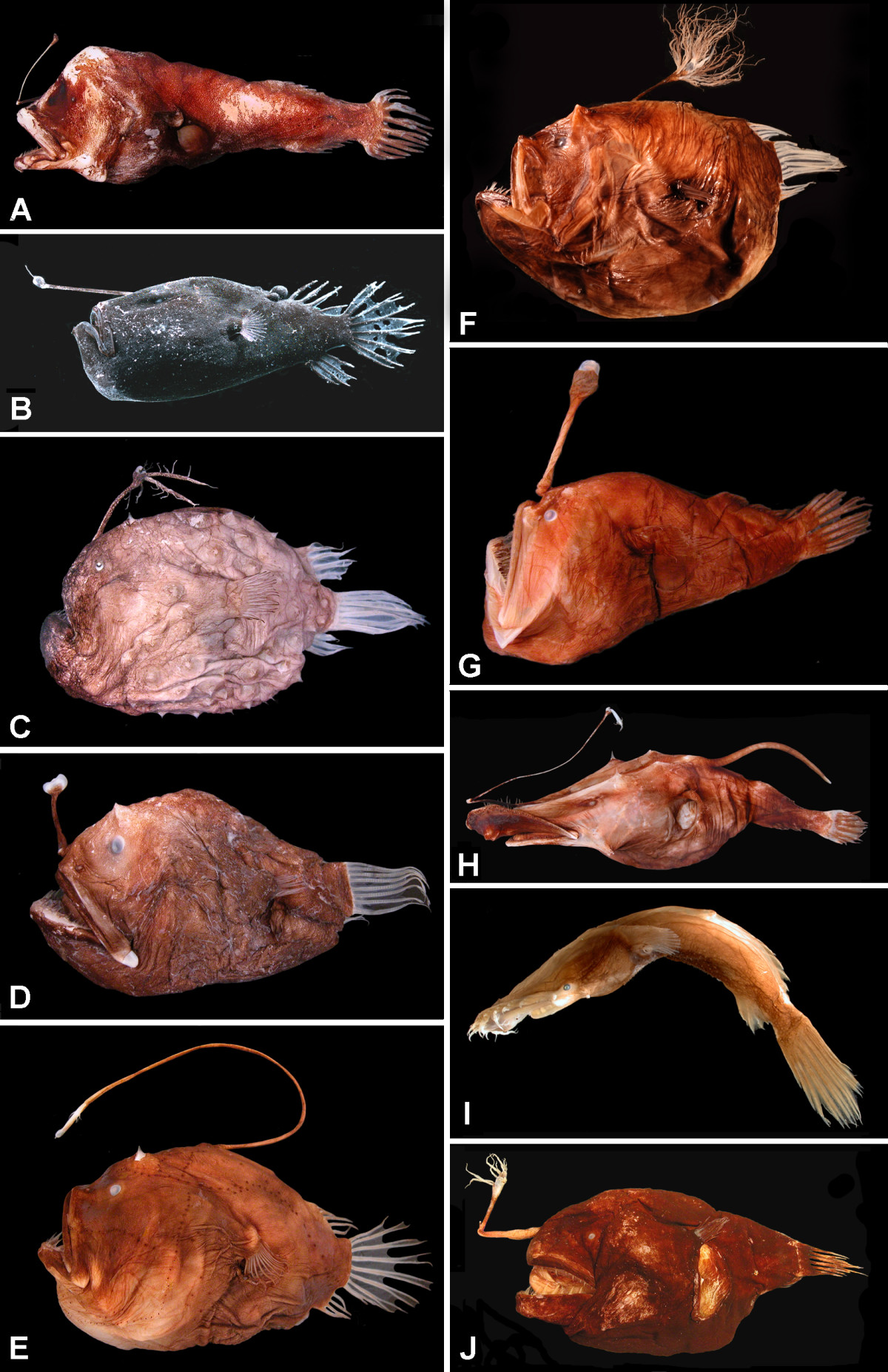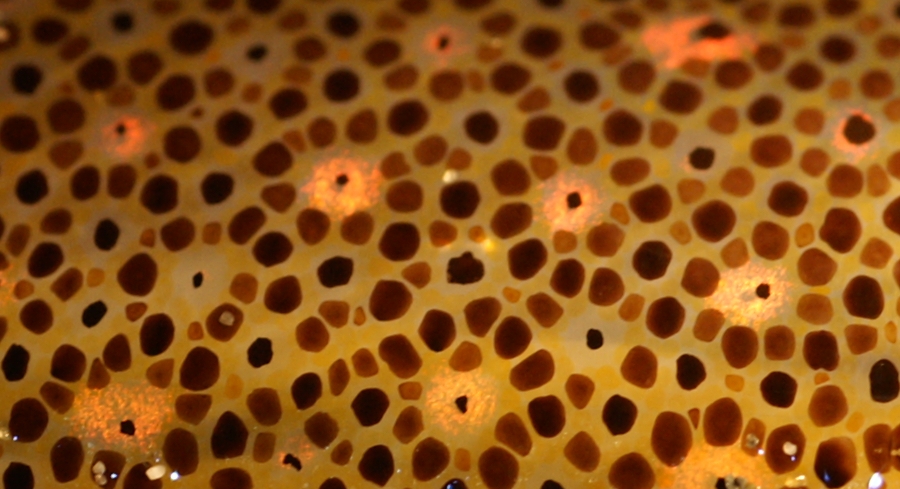|
Centrophrynidae
The horned lantern fish or prickly seadevil (''Centrophryne spinulosa'') is a deep-sea anglerfish found worldwide. It is the monotypic, sole species in the family Centrophrynidae, distinguished from other deep-sea anglerfishes by various characters including four pectoral radials, an anterior spine on the subopercular bone, and a short hyoid (chin) barbel in both sexes. Distribution The horned lantern fish occurs in the Pacific Ocean from Baja California south to the Marquesas Islands and the Gulf of California. Specimens have also been captured in other locations, including New Guinea, the South China Sea, Venezuela, and the Mozambique Channel, suggesting a wide oceanic distribution in tropical and subtropical waters. Specimens were caught at depths from 650 to over 2000 m (2130–6560 ft), while larvae have been recovered close to the surface to a depth of . Description The female horned lantern fish measures up to in length and is long and slender, with a large head and ... [...More Info...] [...Related Items...] OR: [Wikipedia] [Google] [Baidu] |
Lophiiformes
The anglerfish are fish of the teleost order Lophiiformes (). They are bony fish named for their characteristic mode of predation, in which a modified luminescent fin ray (the esca or illicium) acts as a lure for other fish. The luminescence comes from symbiotic bacteria, which are thought to be acquired from seawater, that dwell in and around the sea. Some anglerfish are notable for extreme sexual dimorphism and sexual symbiosis of the small male with the much larger female, seen in the suborder Ceratioidei, the deep sea anglerfish. In these species, males may be several orders of magnitude smaller than females. Anglerfish occur worldwide. Some are pelagic (dwelling away from the sea floor), while others are benthic (dwelling close to the sea floor). Some live in the deep sea (such as the Ceratiidae), while others on the continental shelf, such as the frogfishes and the Lophiidae (monkfish or goosefish). Pelagic forms are most often laterally compressed, whereas the be ... [...More Info...] [...Related Items...] OR: [Wikipedia] [Google] [Baidu] |
Animal
Animals are multicellular, eukaryotic organisms in the Kingdom (biology), biological kingdom Animalia. With few exceptions, animals Heterotroph, consume organic material, Cellular respiration#Aerobic respiration, breathe oxygen, are Motility, able to move, can Sexual reproduction, reproduce sexually, and go through an ontogenetic stage in which their body consists of a hollow sphere of Cell (biology), cells, the blastula, during Embryogenesis, embryonic development. Over 1.5 million Extant taxon, living animal species have been Species description, described—of which around 1 million are Insecta, insects—but it has been estimated there are over 7 million animal species in total. Animals range in length from to . They have Ecology, complex interactions with each other and their environments, forming intricate food webs. The scientific study of animals is known as zoology. Most living animal species are in Bilateria, a clade whose members have a Symmetry in biology#Bilate ... [...More Info...] [...Related Items...] OR: [Wikipedia] [Google] [Baidu] |
Mozambique Channel
The Mozambique Channel (french: Canal du Mozambique, mg, Lakandranon'i Mozambika, pt, Canal de Moçambique) is an arm of the Indian Ocean located between the Southeast African countries of Madagascar and Mozambique. The channel is about long and across at its narrowest point, and reaches a depth of about off the coast of Mozambique. A warm current, the Mozambique Current, flows in a southward direction in the channel, leading into the Agulhas Current off the east coast of Southern Africa. Extent The International Hydrographic Organization (IHO) defines the limits of the Mozambique Channel as follows: ::''On the North.'' A line from the estuary of the River Rovuma () to Ras Habu, the northernmost point of Ile Grande Comore, the northernmost of the Comore (Comoro) Islands, to Cap d'Ambre (Cape Amber), the northern extremity of Madagascar (). ::''On the East.'' The west coast of Madagascar. ::''On the South.'' A line from Cap Sainte-Marie, the southern extremity of M ... [...More Info...] [...Related Items...] OR: [Wikipedia] [Google] [Baidu] |
Bioluminescent
Bioluminescence is the production and emission of light by living organisms. It is a form of chemiluminescence. Bioluminescence occurs widely in marine vertebrates and invertebrates, as well as in some fungi, microorganisms including some bioluminescent bacteria, and terrestrial arthropods such as fireflies. In some animals, the light is bacteriogenic, produced by symbiotic bacteria such as those from the genus ''Vibrio''; in others, it is autogenic, produced by the animals themselves. In a general sense, the principal chemical reaction in bioluminescence involves a light-emitting molecule and an enzyme, generally called luciferin and luciferase, respectively. Because these are generic names, luciferins and luciferases are often distinguished by the species or group, e.g. firefly luciferin. In all characterized cases, the enzyme catalyzes the oxidation of the luciferin. In some species, the luciferase requires other cofactors, such as calcium or magnesium ions, and some ... [...More Info...] [...Related Items...] OR: [Wikipedia] [Google] [Baidu] |
Melanocetus Johnsonii
The humpback anglerfish (''Melanocetus johnsonii'') is a species of black seadevils in the family of Melanocetidae, which means "black whale" in Greek.Froese, R., Pauly D., Eds. (2015) Melanocetus johnsonii. ''FishBase''. The species is named after James Yate Johnson, the English naturalist who discovered the first specimen in Madeira in 1863.Fitch, J.E., Lavenberg R.J. (1968). ''Deep-water teleostean fishes of California.'' University of California Press, 115. The common names include anglerfish, viperfish and fangtoothfish.Humpback Blackdevil, ''Melanocetus johnsonii'' Gunther, 1864. Australian Museum. Historical background The first specimen of ''M. johnsonii'' was discovered by the English naturalist |
Epithelial
Epithelium or epithelial tissue is one of the four basic types of animal tissue, along with connective tissue, muscle tissue and nervous tissue. It is a thin, continuous, protective layer of compactly packed cells with a little intercellular matrix. Epithelial tissues line the outer surfaces of organs and blood vessels throughout the body, as well as the inner surfaces of cavities in many internal organs. An example is the epidermis, the outermost layer of the skin. There are three principal shapes of epithelial cell: squamous (scaly), columnar, and cuboidal. These can be arranged in a singular layer of cells as simple epithelium, either squamous, columnar, or cuboidal, or in layers of two or more cells deep as stratified (layered), or ''compound'', either squamous, columnar or cuboidal. In some tissues, a layer of columnar cells may appear to be stratified due to the placement of the nuclei. This sort of tissue is called pseudostratified. All glands are made up of epith ... [...More Info...] [...Related Items...] OR: [Wikipedia] [Google] [Baidu] |
Villus
Villus ( la, "shaggy hair", plural villi) may refer to: * Intestinal villus, refers to any one of the small, finger-shaped outgrowths of the epithelial lining of the wall of the intestine. Clusters of projections are referred as intestinal villi. * Chorionic villi, found on the surface of the outermost membrane (the chorion) of the fetus * Arachnoid villi, located on the arachnoid membrane of the brain See also * Villi (other) Villi may refer to: *Plural of Villus (other) *'' Le Villi'', an opera-ballet of 1884 by Giacomo Puccini * Ilkka Villi (born 1975), Finnish actor and writer * Villi Bossi (born 1939), Italian sculptor * Villi Hermann (born 1941), Swiss f ... * {{disambiguation no:Tarmtott ... [...More Info...] [...Related Items...] OR: [Wikipedia] [Google] [Baidu] |
Ovary
The ovary is an organ in the female reproductive system that produces an ovum. When released, this travels down the fallopian tube into the uterus, where it may become fertilized by a sperm. There is an ovary () found on each side of the body. The ovaries also secrete hormones that play a role in the menstrual cycle and fertility. The ovary progresses through many stages beginning in the prenatal period through menopause. It is also an endocrine gland because of the various hormones that it secretes. Structure The ovaries are considered the female gonads. Each ovary is whitish in color and located alongside the lateral wall of the uterus in a region called the ovarian fossa. The ovarian fossa is the region that is bounded by the external iliac artery and in front of the ureter and the internal iliac artery. This area is about 4 cm x 3 cm x 2 cm in size.Daftary, Shirish; Chakravarti, Sudip (2011). Manual of Obstetrics, 3rd Edition. Elsevier. pp. 1-16. . ... [...More Info...] [...Related Items...] OR: [Wikipedia] [Google] [Baidu] |
Sexual Dimorphism
Sexual dimorphism is the condition where the sexes of the same animal and/or plant species exhibit different morphological characteristics, particularly characteristics not directly involved in reproduction. The condition occurs in most animals and some plants. Differences may include secondary sex characteristics, size, weight, colour, markings, or behavioural or cognitive traits. These differences may be subtle or exaggerated and may be subjected to sexual selection and natural selection. The opposite of dimorphism is ''monomorphism'', which is when both biological sexes are phenotypically indistinguishable from each other. Overview Ornamentation and coloration Common and easily identified types of dimorphism consist of ornamentation and coloration, though not always apparent. A difference in coloration of sexes within a given species is called sexual dichromatism, which is commonly seen in many species of birds and reptiles. Sexual selection leads to the exaggerat ... [...More Info...] [...Related Items...] OR: [Wikipedia] [Google] [Baidu] |
Barbel (anatomy)
In fish anatomy and turtle anatomy, a barbel is a slender, whiskerlike sensory organ near the mouth. Fish that have barbels include the catfish, the carp, the goatfish, the hagfish, the sturgeon, the zebrafish, the black dragonfish and some species of shark such as the sawshark. Barbels house the taste buds of such fish and are used to search for food Food is any substance consumed by an organism for nutritional support. Food is usually of plant, animal, or fungal origin, and contains essential nutrients, such as carbohydrates, fats, proteins, vitamins, or minerals. The substance is ... in murky water. The word "barbel" comes from the Middle Latin ''barbula'', for "little beard." Barbels are sometimes erroneously referred to as '' barbs'', which are found in bird feathers for flight. Barbels may be located in a variety of locations on the head of a fish. "Maxillary barbels" refers to barbels on either side of the mouth. Barbels may also be nasal, exten ... [...More Info...] [...Related Items...] OR: [Wikipedia] [Google] [Baidu] |
Melanophore
Chromatophores are cells that produce color, of which many types are pigment-containing cells, or groups of cells, found in a wide range of animals including amphibians, fish, reptiles, crustaceans and cephalopods. Mammals and birds, in contrast, have a class of cells called melanocytes for coloration. Chromatophores are largely responsible for generating skin and eye colour in ectothermic animals and are generated in the neural crest during embryonic development. Mature chromatophores are grouped into subclasses based on their colour (more properly " hue") under white light: xanthophores (yellow), erythrophores (red), iridophores ( reflective / iridescent), leucophores (white), melanophores (black/brown), and cyanophores (blue). While most chromatophores contain pigments that absorb specific wavelengths of light, the color of leucophores and iridophores is produced by their respective scattering and optical interference properties. Some species can rapidly change colour ... [...More Info...] [...Related Items...] OR: [Wikipedia] [Google] [Baidu] |






